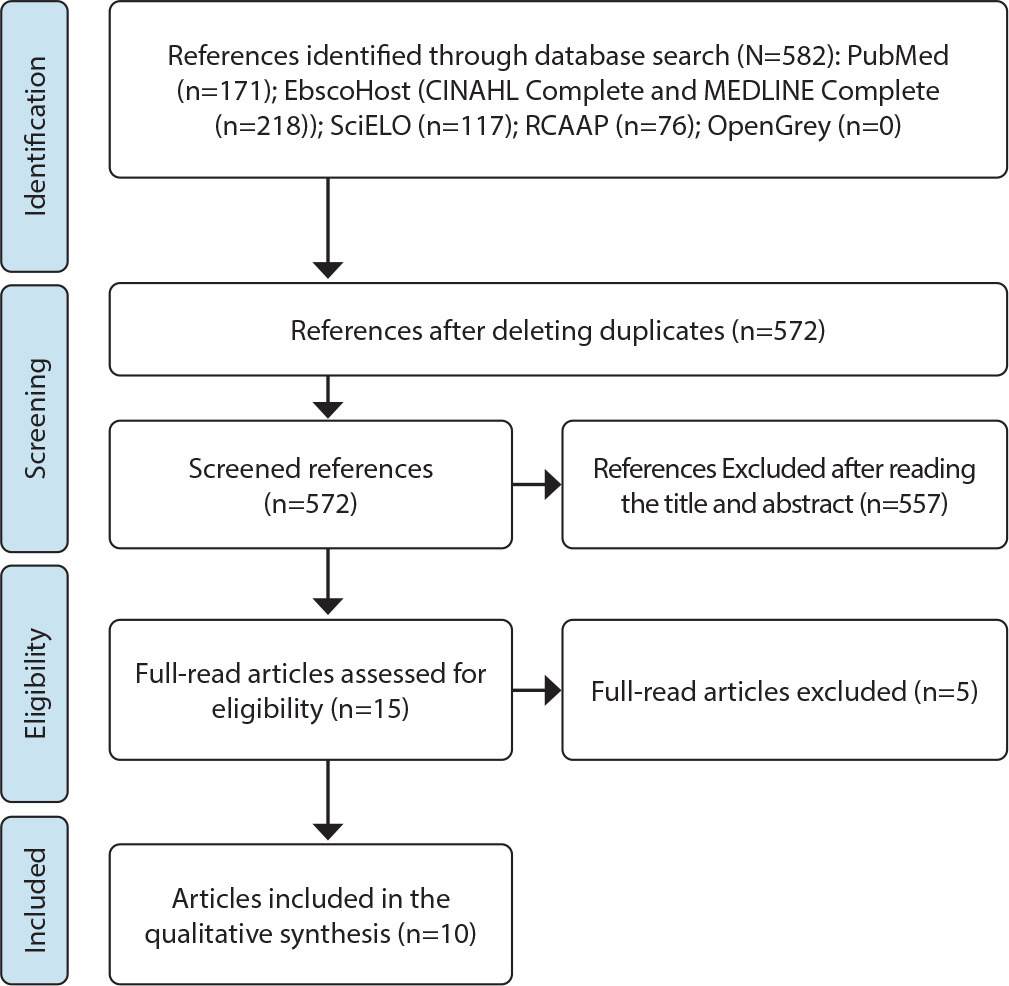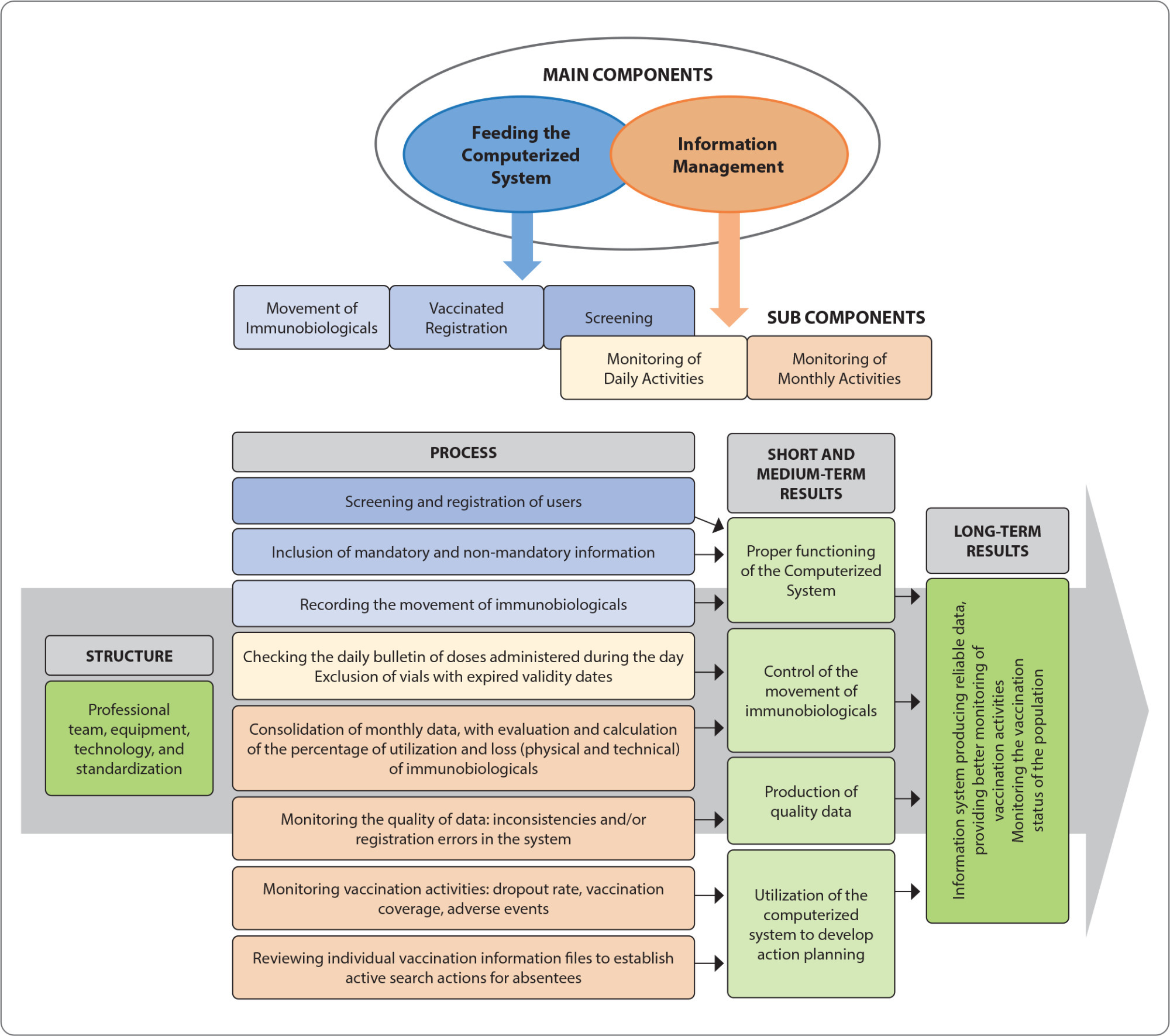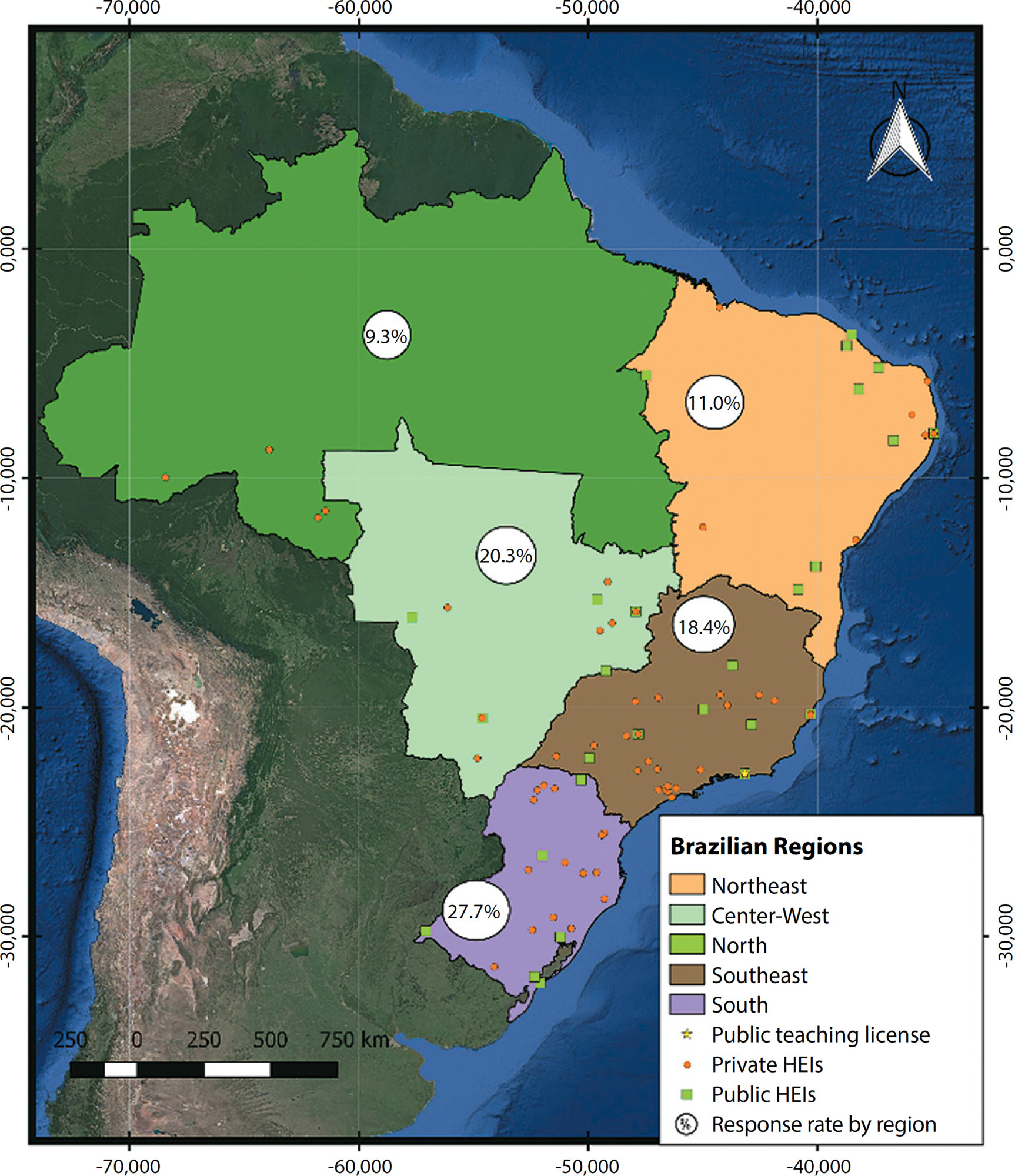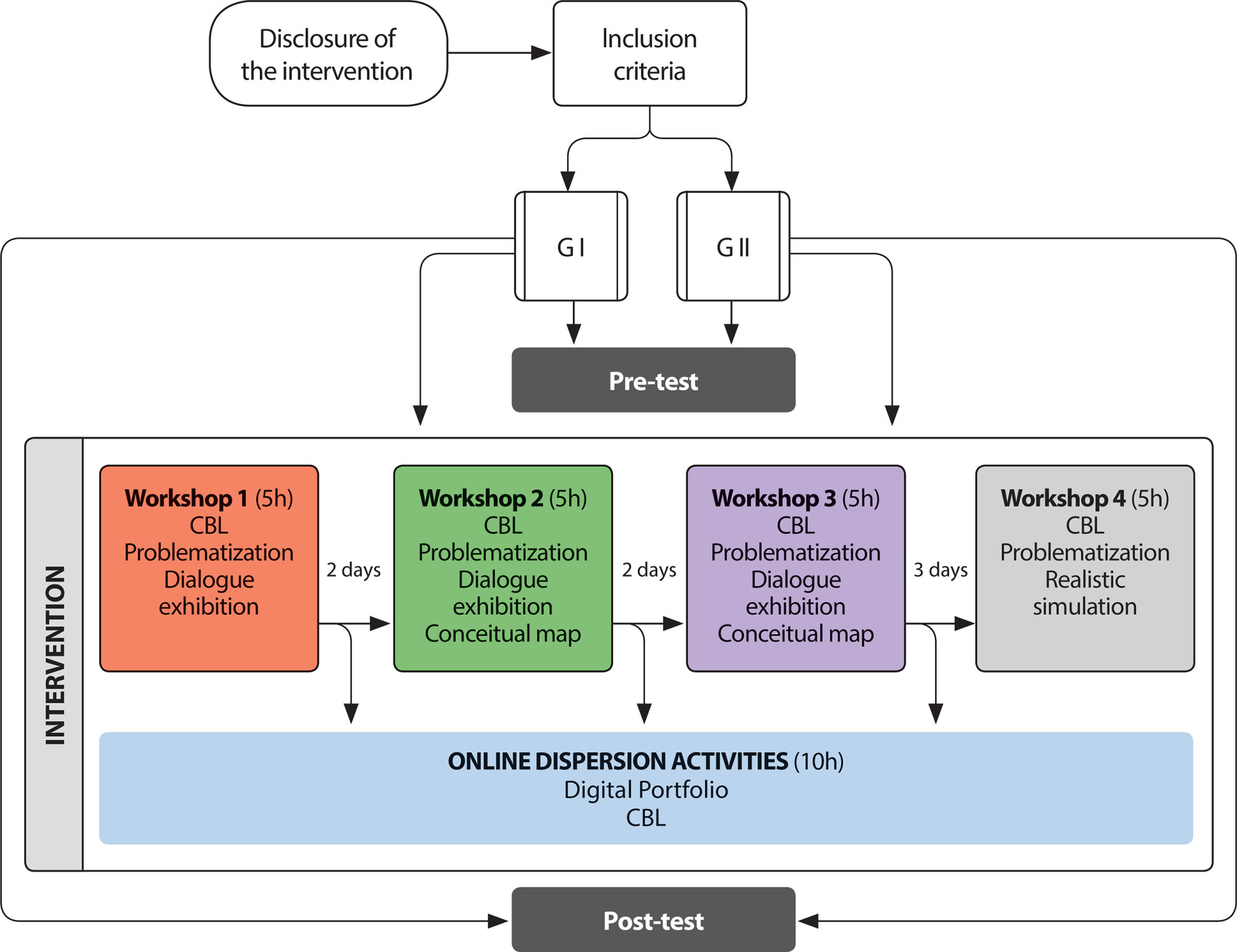-
ORIGINAL ARTICLE11-22-2024
Bedside rounds in the hospital environment from the perspective of multiprofessional health teams
Revista Brasileira de Enfermagem. 2024;77(5):e20230493
Abstract
ORIGINAL ARTICLEBedside rounds in the hospital environment from the perspective of multiprofessional health teams
Revista Brasileira de Enfermagem. 2024;77(5):e20230493
DOI 10.1590/0034-7167-2023-0493
Views0ABSTRACT
Objective:
To analyze the configuration of power relations among the multiprofessional team in the bedside round process in the hospital.
Methods:
Qualitative research with data analyzed through discourse analysis, based on Michel Foucault’s theoretical framework. From September to December 2022, we conducted interviews and field observations with the multiprofessional team at a hospital in Belo Horizonte, Minas Gerais, Brazil, as well as qualitative, semi-structured interviews with 37 professionals.
Results:
The participants pointed out that the experiences of the professionals involved in bedside rounds depend on how the physician conducts the process, and the physician-centered process makes it difficult for other professionals in the team to participate.
Final considerations:
The way hospitals organize bedside rounds does not promote knowledge articulation for their professionals. It hinders the circulation of power and harms interdisciplinary work in a process that maintains the physician as the main actor in clinical decisions.
Keywords:Health Knowledge, Attitudes, PracticeHospitalsInterprofessional RelationsPatient Care TeamProfessional PracticeSee more -
REVIEW11-22-2024
Transition to family parenting in the face of the first child: a scoping review
Revista Brasileira de Enfermagem. 2024;77(5):e20230487
Abstract
REVIEWTransition to family parenting in the face of the first child: a scoping review
Revista Brasileira de Enfermagem. 2024;77(5):e20230487
DOI 10.1590/0034-7167-2023-0487
Views1See moreABSTRACT
Objectives:
to identify and summarize the elements that characterize the family transition process in relation to the first child.
Methods:
a scoping review was carried out based on JBI methodology, in six databases, following the Preferred Reporting Items for Systematic reviews and Meta-Analyses extension for Scoping Reviews checklist.
Results:
ten articles were included with factors characterizing the transition, such as hindering/facilitating conditions that influence the process, important support structures in adaptation and strategies/responses used in the transition process.
Final Considerations:
elements characterizing the transition process in relation to the first child were identified. However, no theoretical explanation for this was identified. Further research should be carried out to obtain a deeper understanding of this process.

-
ORIGINAL ARTICLE11-22-2024
Prevalence of prescription and effectiveness of analgesia for treating vaginal delivery pain
Revista Brasileira de Enfermagem. 2024;77(5):e20230327
Abstract
ORIGINAL ARTICLEPrevalence of prescription and effectiveness of analgesia for treating vaginal delivery pain
Revista Brasileira de Enfermagem. 2024;77(5):e20230327
DOI 10.1590/0034-7167-2023-0327
Views0See moreABSTRACT
Objectives:
to assess pain management during labor.
Methods:
a cross-sectional study was carried out by reviewing medical records and conducting postpartum interviews. Prevalence and effectiveness of analgesia were assessed.
Results:
the prevalence of non-pharmacological analgesia was 61.86% of 215 women in labor in Obstetric Center and 82.51% of 62 in midwife-led unit. Prevalence of severe pain, on the Visual Analogue Scale, before and after non-pharmacological analgesia, was from 92.16% to 64.04% (p=0.00) in Obstetric Center and from 85.96% to 52.63% (p=0.01) in midwife-led unit. Prevalence of pharmacological analgesia in Obstetric Centers was 15.81%, with no variation in severe pain (p=0.57). Patients’ request for analgesia was associated with education (p=0.00) and pain intensity (p=0.02).
Conclusions:
non-pharmacological analgesia improved pain intensity. Prevalence of pharmacological analgesic prescription was lower than that identified in developed countries. Pain management needs to consider the preferences and needs of women in labor.
-
11-22-2024
Social Technology in the Prevention of Adolescent Violence: documentary production
Revista Brasileira de Enfermagem. 2024;77(5):e20230298
Abstract
Social Technology in the Prevention of Adolescent Violence: documentary production
Revista Brasileira de Enfermagem. 2024;77(5):e20230298
DOI 10.1590/0034-7167-2023-0298
Views0See moreABSTRACT
Objective:
To report the development of a technological innovation in the form of a documentary, aimed at disseminating actions for preventing violence against adolescents within the context of Primary Health Care.
Methods:
The documentary was developed through action research and interventions with adolescents in the territory of a Health Unit, conducted between 2020 and 2022, using Social Technology as both an action strategy and a conceptual reference.
Results:
The Social Technology proposal, created through workshops and seminars, resulted in a documentary focusing on violence prevention, involving 48 adolescents. The documentary’s script, collectively developed, portrays a soccer match between teams symbolizing peace and violence, with peace ultimately prevailing. The documentary is six minutes long.
Final Considerations:
The documentary has proven to be an effective Social Technology tool among adolescents, as it fosters critical thinking, is accessible, has potential for digital dissemination, and appeals to the target audience.
-
ORIGINAL ARTICLE11-22-2024
Study for the validation of evaluation indicators of electronic health records in immunization: Delphi technique
Revista Brasileira de Enfermagem. 2024;77(5):e20230112
Abstract
ORIGINAL ARTICLEStudy for the validation of evaluation indicators of electronic health records in immunization: Delphi technique
Revista Brasileira de Enfermagem. 2024;77(5):e20230112
DOI 10.1590/0034-7167-2023-0112
Views0See moreABSTRACT
Objective:
To develop and validate indicators for the evaluation of computerized systems in vaccination rooms.
Methods:
Methodological study. From the construction of a logical model for managing information produced in computerized systems in vaccination rooms, an evaluation indicator matrix was developed, and its contents were validated by specialists using the Delphi method. The degree of relevance and clarity were judged, using the following parameters: agreement percentage ≥ 90%; content validity index > 0.78. Internal consistency was tested using Cronbach’s alpha coefficient of 0.93.
Results:
Of the 55 proposed indicators, 48 were validated and composed the final matrix, with 13 in the structure dimension, 29 in the process dimension, and six in the outcome dimension.
Conclusion:
The set of indicators shows validity and high reliability, and can be used to evaluate computerized systems in vaccination rooms throughout the country, as it adhered to the recommendations of the National Immunization Program.

-
11-22-2024
Rondas a beira leito no ambiente hospitalar na perspectiva de equipes multiprofissionais de saúde
Revista Brasileira de Enfermagem. 2024;77(5):e20230493
Abstract
Rondas a beira leito no ambiente hospitalar na perspectiva de equipes multiprofissionais de saúde
Revista Brasileira de Enfermagem. 2024;77(5):e20230493
DOI 10.1590/0034-7167-2023-0493
Views0See moreRESUMEN
Objetivo:
Analizar la configuración de las relaciones de poder entre el equipo multiprofesional en el proceso de rondas de cabecera en el hospital.
Método:
Investigación cualitativa con datos analizados a través del análisis del discurso, basado en el marco teórico de Michel Foucault. De septiembre a diciembre de 2022, realizamos entrevistas y observaciones de campo con el equipo multiprofesional de un hospital de Belo Horizonte, Minas Gerais, Brasil, así como entrevistas cualitativas semiestructuradas con 37 profesionales.
Resultados:
Los participantes señalaron que las experiencias de los profesionales involucrados en las rondas de cabecera dependen de cómo el médico conduce el proceso, y el proceso centrado en el médico dificulta la participación de otros profesionales del equipo.
Consideraciones finales:
La forma en que los hospitales organizan las rondas de cabecera no promueve la articulación del conocimiento de sus profesionales. Además, dificulta la circulación del poder y perjudica el trabajo interdisciplinario en un proceso que mantiene al médico como actor principal de las decisiones clínicas.
-
ORIGINAL ARTICLE11-22-2024
Knowledge sharing: nurse managers’ practices
Revista Brasileira de Enfermagem. 2024;77(5):e20230287
Abstract
ORIGINAL ARTICLEKnowledge sharing: nurse managers’ practices
Revista Brasileira de Enfermagem. 2024;77(5):e20230287
DOI 10.1590/0034-7167-2023-0287
Views0See moreABSTRACT
Objective:
To analyze how management practices for sharing knowledge are developed in public hospitals in the context of nursing.
Methods:
Qualitative research, carried out with 15 nurse managers from six public hospitals, from July to September 2022. Data were collected through semi-structured interviews and analyzed according to content analysis and in a model for sharing knowledge at work.
Results:
Knowledge sharing in nursing occurs through intraand extra-organizational training (training, courses and events), use of digital communication tools (media and social networks) and individual and collective contact between professionals during the service (experiences, exchange of experiences and assessment feedback).
Final considerations:
Sharing knowledge is relevant to nursing work. To improve it, it must be understood that effective sharing occurs from person to person, in their daily practices, and must be conducted as a strategically planned process by nurse managers.
-
ORIGINAL ARTICLE11-22-2024
Interpersonal violence in the state of Espírito Santo: analysis of mandatory notifications between 2011 and 2018
Revista Brasileira de Enfermagem. 2024;77(5):e20230081
Abstract
ORIGINAL ARTICLEInterpersonal violence in the state of Espírito Santo: analysis of mandatory notifications between 2011 and 2018
Revista Brasileira de Enfermagem. 2024;77(5):e20230081
DOI 10.1590/0034-7167-2023-0081
Views0See moreABSTRACT
Objective:
To identify the frequency of notifications of interpersonal violence in Espírito Santo from 2011 to 2018, and the factors associated with this issue.
Methods:
This is a cross-sectional study in which all cases of interpersonal violence from the Information System for Notifiable Diseases in the state of Espírito Santo during the period from 2011 to 2018 were analyzed. Absolute and relative frequencies and 95% confidence intervals were calculated, as well as Poisson regression.
Results:
During the analyzed period, 27,277 cases were reported in Espírito Santo (P: 75%; 95% CI: 74.5-75.4), being more prevalent among females, children, and the elderly, individuals of black/mixed race, people without disabilities, and residents of urban areas. Regarding the perpetrator, there was a higher prevalence of individuals aged 25 years and older, males, with a current or former intimate partner relationship with the victim, and suspected alcohol use at the time of the aggression. In terms of the characteristics of the aggression, there was a higher prevalence of repeat violence, involving a single aggressor, and occurring in the residence.
Conclusions:
The notification of interpersonal violence in Espírito Santo showed a high prevalence and was associated with characteristics of the victim, aggressor, and event. This scenario reinforces the need for interventions such as professional qualification, expansion of intersectoral actions, and reformulation of public policies.
-
EXPERIENCE REPORT01-01-2018
Clinical and epidemiological teaching of dengue through simulated practice
Revista Brasileira de Enfermagem. 2018;71(2):451-456
Abstract
EXPERIENCE REPORTClinical and epidemiological teaching of dengue through simulated practice
Revista Brasileira de Enfermagem. 2018;71(2):451-456
DOI 10.1590/0034-7167-2016-0503
Views2See moreABSTRACT
Objective:
to describe the experience of clinical teaching on dengue and the practice of epidemiological surveillance using problematization methodology.
Method:
report of experience on educational activity with undergraduate nursing students, held in March 2016, at a public university in the city of São Paulo, conceived in four stages: dialogic lecture, active search of Aedes aegypti, case study and simulation of nursing consultation to individuals with dengue.
Results:
The activity allowed to retrieve previous knowledge about the disease, respond to exercises that addressed different clinical situations and epidemiological surveillance, including in situ evaluation of possible mosquito outbreaks, and discuss the need to expand prevention and health of the individual and the community, the impact of the media in the dissemination of cases and the coping difficulties experienced in the different levels of attention.
Conclusion:
the methodology adopted enabled qualified training of students to cope with dengue.

-
ORIGINAL ARTICLE07-18-2022
Beliefs, knowledge, actions of nursing techniques in breastfeeding in pain management in immunization
Revista Brasileira de Enfermagem. 2022;75(6):e20210546
Abstract
ORIGINAL ARTICLEBeliefs, knowledge, actions of nursing techniques in breastfeeding in pain management in immunization
Revista Brasileira de Enfermagem. 2022;75(6):e20210546
DOI 10.1590/0034-7167-2021-0546
Views1See moreABSTRACT
Objective:
Understand the beliefs, knowledge, and actions of nursing technicians on breastfeeding as a form of non-pharmacological intervention to relieve pain in newborns and infants during immunization.
Methods:
Qualitative study carried out through semi-structured interviews with nine nursing technicians from three Basic Health Units in a city in the state of São Paulo. The theoretical approach of the Belief Model and the methodological framework of Thematic Analysis supported this study.
Results:
Three themes originated: Beliefs, Knowledge, and Actions of nursing technicians.
Final considerations:
Despite knowledge about the benefits of breastfeeding as the most effective method for relieving pain in newborns and infants during vaccination, their restrictive beliefs overrode the evidence, leading them to act in ways that discourage or prevent the mother from breastfeed during vaccination. Formal training is recommended to align with current evidence-based practices.
-
REVIEW12-08-2023
Educational technologies for accident prevention due to falls in childhood: a scoping review
Revista Brasileira de Enfermagem. 2023;76:e20220807
Abstract
REVIEWEducational technologies for accident prevention due to falls in childhood: a scoping review
Revista Brasileira de Enfermagem. 2023;76:e20220807
DOI 10.1590/0034-7167-2022-0807
Views2See moreABSTRACT
Objectives:
to map evidence on educational technology use for accident prevention due to falls in childhood.
Methods:
a scoping review, carried out in October and November 2022, in the MEDLINE, Web of Science, BDENF and CINAHL databases and LILACS bibliographic index. There was no delimitation of language or time. Data were extracted and analyzed descriptively by two independent researchers. The research protocol was registered in the Open Science Framework.
Results:
twenty-six studies were selected. Booklets, pamphlets and leaflets were the most used technologies, presenting health services as the most frequent environment to develop research on fall prevention. The technologies developed were important outcomes: increased knowledge of children, family members, caregivers, health and education professionals.
Conclusions:
educational technology use makes it possible to increase knowledge, adopt safe practices and reduce falls.

-
REVIEW03-15-2024
Resources for health literacy among caregivers of prematurely born children: a scoping review
Revista Brasileira de Enfermagem. 2024;77(1):e20230062
Abstract
REVIEWResources for health literacy among caregivers of prematurely born children: a scoping review
Revista Brasileira de Enfermagem. 2024;77(1):e20230062
DOI 10.1590/0034-7167-2023-0062
Views1See moreABSTRACT
Objectives:
to map the available evidence on resources used to promote health literacy among caregivers of prematurely born children during outpatient follow-up.
Methods:
the Joanna Briggs Institute’s scope review protocol was utilized. The search encompassed six databases, incorporating studies from 2012 to 2022.
Results:
the three included publications revealed that the resources employed are: mobile applications, phone calls, individual counseling, videos, educational pamphlets, and group discussions. Implementing an education protocol during the transition home enhances scientifically grounded health promotion rates.
Conclusions:
there is limited literature addressing the health literacy of these caregivers. The nursing team plays a crucial role in health education and in developing resources applicable to these families.

-
ORIGINAL ARTICLE01-13-2024
Social representations of oncologic surgery for patients with cancer
Revista Brasileira de Enfermagem. 2024;77(6):e20230273
Abstract
ORIGINAL ARTICLESocial representations of oncologic surgery for patients with cancer
Revista Brasileira de Enfermagem. 2024;77(6):e20230273
DOI 10.1590/0034-7167-2023-0273
Views2See moreABSTRACT
Objectives:
to analyze the social representations of patients with cancer regarding oncologic surgery.
Methods:
a qualitative study based on Social Representation Theory was conducted with 126 participants between October 2021 and May 2022 in a public hospital in Rio de Janeiro. A characterization questionnaire, free evocations of the inducing term “surgery”, and semi-structured interviews with 60 participants were applied. Data were analyzed using Microsoft Excel® and IRaMuTeQ.
Results:
the central core of the representation is composed of fear, cure, hope, and removing the disease. The analysis of interviews resulted in six classes that highlight the social changes caused by treatment as well as the need for a support network to cope with the surgical process.
Final Considerations:
the representations reflect fear and hope towards the procedure and the desire to remove the disease, thus translating the cure through surgery.

-
ORIGINAL ARTICLE01-13-2024
Nurses’ perspectives on the use of telemonitoring in the management of people with diabetes and hypertension
Revista Brasileira de Enfermagem. 2024;77(6):e20230481
Abstract
ORIGINAL ARTICLENurses’ perspectives on the use of telemonitoring in the management of people with diabetes and hypertension
Revista Brasileira de Enfermagem. 2024;77(6):e20230481
DOI 10.1590/0034-7167-2023-0481
Views3See moreABSTRACT
Objectives:
to understand the perspective of nurses on the use of telemonitoring in the management of people with type 2 diabetes mellitus and arterial hypertension in primary care.
Methods:
this qualitative research involved sixteen nurses from eight municipalities in Paraná. Data were collected between November 2022 and January 2023 through inperson or remote interviews, which were audio-recorded and subjected to content analysis.
Results:
according to the nurses, telemonitoring enhances users’ knowledge about these conditions, communication and connection with the team, and productivity. However, the lack of electronic resources and equipment, high staff turnover, low user adherence, and the limited availability of professional time present significant challenges.
Final Considerations:
the effective implementation and operation of telemonitoring in the management of people with diabetes and hypertension involve both potential benefits and barriers. It is essential to have the availability of human and technological resources, managerial support, and the commitment of professionals and users.
-
ERRATUM01-13-2024
ERRATUM
Revista Brasileira de Enfermagem. 2024;77(6):e2024n6e08
Abstract
ERRATUMERRATUM
Revista Brasileira de Enfermagem. 2024;77(6):e2024n6e08
DOI 10.1590/0034-7167.20247706e08
Views2In the article “Brazilian nursing specific situation, middle and micro-range theories: a bibliometric study”, with DOI number: , published in Revista Brasileira de Enfermagem, 2024;77(4):e20230520, Chart 1:Where it read:[…]See more -
ORIGINAL ARTICLE09-29-2022
Palliative care production for health professionals in the context of home care
Revista Brasileira de Enfermagem. 2022;75(1):e20210030
Abstract
ORIGINAL ARTICLEPalliative care production for health professionals in the context of home care
Revista Brasileira de Enfermagem. 2022;75(1):e20210030
DOI 10.1590/0034-7167-2021-0030
Views1See moreABSTRACT
Objectives:
to analyze palliative care production developed by health professionals to home care patients.
Methods:
this is an exploratory study, with a qualitative approach, using the transpersonal care theoretical framework. Thirteen interviews were conducted with health professionals and 18 observations were conducted on different cases. Content analysis was performed using MAXQDA©.
Results:
actions performed: maintenance and follow-up measures to people eligible for palliative care, in acts of dialogue and “listening” to caregivers and users, conducting guidelines for the care and self-care process, performing technical procedures, delivery of materials, referrals and medical prescriptions to users.
Final Considerations:
it is perceived the need for advances in the implementation of government policies in Brazil that insert palliative care into the Health Care Network through educational, managerial and care actions that ensure human dignity, thus allowing the development of these and other palliative care interventions.
-
ORIGINAL ARTICLE04-14-2023
Artificial intelligence in the analysis of emotions of nursing students undergoing clinical simulation
Revista Brasileira de Enfermagem. 2023;76:e20210909
Abstract
ORIGINAL ARTICLEArtificial intelligence in the analysis of emotions of nursing students undergoing clinical simulation
Revista Brasileira de Enfermagem. 2023;76:e20210909
DOI 10.1590/0034-7167-2021-0909
Views0See moreABSTRACT
Objective:
to assess nursing students’ emotions undergoing maternal-child clinical simulation.
Methods:
an observational study, carried out between June and July 2019. The Focus Group technique was used, with 28 nursing students, randomly distributed into three groups, with qualitative (Bardin technique) and quantitative data (Artificial Intelligence) analysis, to analyze emotions through facial expressions, tone of voice and description of speeches.
Results:
we defined two categories: “It was not easy, it was very stressful”; and “Very valuable experience”. In Artificial Intelligence, emotional distribution between face, voice and speech revealed a prevalence of negative valence, medium-high degree of passivity, medium power to control the situation and medium-high degree of obstruction in task accomplishment.
Final considerations:
this study revealed an oscillation between positive and negative emotions, and shows to the importance of recognizing them in the teaching-learning process in mother-child simulation.

-
04-26-2021
Content validity of the nursing diagnostic Breathing Pattern, Ineffective, in children with congenital heart defects
Revista Brasileira de Enfermagem. 2021;74:e20190844
Abstract
Content validity of the nursing diagnostic Breathing Pattern, Ineffective, in children with congenital heart defects
Revista Brasileira de Enfermagem. 2021;74:e20190844
DOI 10.1590/0034-7167-2019-0844
Views0See moreABSTRACT
Objective:
To estimate the content validity of the nursing diagnostic Breathing Pattern, Ineffective, in children with congenital heart defects.
Method:
Methodological study in two stages: 1) integrative literature review; 2) content validation, with 23 nurses. An instrument with 10 related factors and 21 defining characteristics for data collection was used. The analysis by the evaluators was carried out using the relevance criteria. The Content Validity Index was used. Valid results were those above 0.9 with a Wilcoxon test above 0.05.
Results:
The final proposal incorporates nine from the ten causal factors. From them, five do not belong in the NANDA-I list. Regarding the defining characteristics, they were all considered to be relevant, and five are not among the list of signs and symptoms of the NANDA-I taxonomy.
Conclusion:
The findings of this study include specific elements of the pediatric population with congenital heart defect which are not present in the structure of the diagnostic being studied.
-
06-11-2021
Influence of social determinants of health on skin to skin contact between mother and newborn
Revista Brasileira de Enfermagem. 2021;74:e20200138
Abstract
Influence of social determinants of health on skin to skin contact between mother and newborn
Revista Brasileira de Enfermagem. 2021;74:e20200138
DOI 10.1590/0034-7167-2020-0138
Views0See moreABSTRACT
Objective:
to analyze the association of skin-to-skin contact and social determinants of health.
Methods:
this is a cross-sectional study with 187 medical records of newborns from a reference rooming in in northeastern Brazil. An instrument with maternal and neonatal data was used. Analysis was descriptive and inferential statistics. For the associations, a chi-square test was used to measure strength, an Odds Ratio was calculated, with a 95% confidence interval.
Results:
62% of newborns who made skin-to-skin contact at birth were eutrophic, full-term, Apgar > 7, mothers with prenatal care and without abortion. The determinants associated with non-skin-to-skin contact were preterm (CR=3.2;95%CI: 2.72-18.98); 1st minute Apgar < 7 (CR:2.9;95%CI: 2.38-3.06), cesarean section (CR:8.4;95%CI: 4.29-16.57), and unhealthy NB (CR 12.7;95%CI: 4.9-32.67). We used STROBE guidelines.
Conclusion:
skin-to-skin contact was influenced by gestational age, Apgar, delivery, and newborn health.
-
07-09-2021
Sexuality and assessment of physical and psychological symptoms of older adults in outpatient care
Revista Brasileira de Enfermagem. 2021;74:e20200998
Abstract
Sexuality and assessment of physical and psychological symptoms of older adults in outpatient care
Revista Brasileira de Enfermagem. 2021;74:e20200998
DOI 10.1590/0034-7167-2020-0998
Views0See moreABSTRACT
Objective:
to analyze the relationship between affective and sexual experiences and the intensity of physical and psychological symptoms of older adults.
Methods:
observational, cross-sectional and analytical study, guided by the STROBE tool, carried out in a geriatric outpatient clinic. Sociodemographic and health questionnaire, Affective and Sexual Experiences Scale for Elderly, Edmonton Symptom Assessment Scale were used. Descriptive statistical analysis and Spearman correlation were performed.
Results:
forty-five older adults participated, with a mean age of 73.8 years; most (91.1%) were married. The highest averages of symptom intensity were pain (4.9), anxiety (4.8), drowsiness (4.5), and a feeling of well-being (4.5). There was a negative correlation between sadness and the dimensions of sexual activity and affective relationships (rs=-0.365; p=0.014 and rs=-0.386; p=0.009) and between anxiety and sexual activity (rs=-0.308; p=0.040).
Conclusion:
as sadness increases, affective and sexual experiences are less. The greater the anxiety intensity, the lower the sexual experiences.
-
ORIGINAL ARTICLE05-21-2021
Simulation in nursing baccalaureate courses of Brazilian educational institutions
Revista Brasileira de Enfermagem. 2021;74:e20190730
Abstract
ORIGINAL ARTICLESimulation in nursing baccalaureate courses of Brazilian educational institutions
Revista Brasileira de Enfermagem. 2021;74:e20190730
DOI 10.1590/0034-7167-2019-0730
Views0See moreABSTRACT
Objective:
to characterize simulation practices in nursing courses in Brazil, considering the attributes developed, facilities, and challenges encountered.
Methods:
this is a cross-sectional and descriptive study, with a quantitative approach. Ninety-one coordinators of undergraduate courses participated in the study. An electronic questionnaire was used with open- and closed-ended questions.
Results:
the most used simulation modality is Specific Skills. Private courses and courses with integrated curricula most often use High Fidelity Simulation. Understanding the mobilization of affective attributes is still insufficient.
Conclusion:
it is important that undergraduate course managers are aware and take ownership of the elements that permeate simulation and invest to create a favorable environment for its effectiveness.

-
ORIGINAL ARTICLE03-19-2021
Active teaching strategies improve nursing knowledge and skills to assist burn victims
Revista Brasileira de Enfermagem. 2021;74:e20200235
Abstract
ORIGINAL ARTICLEActive teaching strategies improve nursing knowledge and skills to assist burn victims
Revista Brasileira de Enfermagem. 2021;74:e20200235
DOI 10.1590/0034-7167-2020-0235
Views0See moreABSTRACT
Objective:
to evaluate the impact of an educational intervention, on nurses’ self-perception, about knowledge and skills for initial care for burn victims.
Methods:
a quasi-experimental study of the type before and after, with 18 nurses who assist burn victims. The intervention was carried out for 11 days in face-to-face meetings and online activities, and comprised active case-based learning strategies, simulation training, concept maps and digital portfolio. A structured instrument was used to collect sociodemographic data, and another one related to the knowledge and essential skills to the initial care for burn victims.
Results:
The average scores found before the intervention ranged from 2.78 to 3.33 and, after the intervention, they ranged from 3.89 to 4.72. Relevant statistical differences (p <0.005) were found in all questions addressed.
Conclusion:
this educational intervention, based on innovative teaching methods, showed a positive impact on nurses’ knowledge and skills on initial care for people with burns.

-
ORIGINAL ARTICLE02-03-2023
Remote teaching during the COVID-19 pandemic: repercussions from professors’ perspective
Revista Brasileira de Enfermagem. 2023;76:e20220172
Abstract
ORIGINAL ARTICLERemote teaching during the COVID-19 pandemic: repercussions from professors’ perspective
Revista Brasileira de Enfermagem. 2023;76:e20220172
DOI 10.1590/0034-7167-2022-0172
Views0See moreABSTRACT
Objectives:
to understand the repercussions of teaching work in remote teaching during the COVID-19 pandemic in Higher Education Institutions in northern Santa Catarina.
Methods:
a qualitative participatory action research, based on Paulo Freire’s theoretical-methodological precepts. Seventeen health professors participated in two Virtual Culture Circles held in the first half of 2021.
Results:
six generating themes emerged for discussion, which aroused in participants’ feelings and perspectives regarding the remote teaching process in the pandemic context, with an emphasis on the connectivity theme, which generated dialogue through reports of personal experiences.
Final Considerations:
the pandemic has had repercussions in sectors such as health and education. Professors talked about their experience in creating, recreating and adapting to remote teaching and the challenges facing the teaching-learning process, listing the worsening of mental health and the need to learn new digital technologies.

-
ORIGINAL ARTICLE12-21-2020
Regional coordinators of Sao Paulo State prisons in tuberculosis and HIV coinfection care
Revista Brasileira de Enfermagem. 2020;73:e20190738
Abstract
ORIGINAL ARTICLERegional coordinators of Sao Paulo State prisons in tuberculosis and HIV coinfection care
Revista Brasileira de Enfermagem. 2020;73:e20190738
DOI 10.1590/0034-7167-2019-0738
Views0See moreABSTRACT
Objectives:
to analyze the care provided to individuals with Tuberculosis (TB)-HIV coinfection in prison units in the state of São Paulo, according to the regional coordination of prisons.
Methods:
cross-sectional study conducted between 2016 and 2018. A structured questionnaire was applied to 112 directors or health professionals from 168 prison units. Data were analyzed by frequency distribution and multiple correspondence analysis.
Results:
92.9% of participants reported active search for respiratory symptoms, 89.3% offer the directly observed treatment (DOT) for all TB cases, 95.5% anti-HIV testing for all inmates, 92.9% offer HIV follow-up in specialized care services and 59.8% antiretroviral drugs for cases of coinfection. An association was identified between the Northwest and Central regional coordinations and deficient human resources and low performance of actions for the diagnosis and follow-up of cases.
Conclusions:
although most prison units perform planned actions for the care of coinfected persons, some places need support to guarantee access to these actions.

Search
Search in:
Nuvem de Tags
Adolescente (85) Atenção Primária à Saúde (239) COVID-19 (91) Criança (91) Cuidados de Enfermagem (269) Educação em Enfermagem (151) Educação em Saúde (139) Enfermagem (930) Enfermagem Pediátrica (86) Estudantes de Enfermagem (77) Estudos de Validação (131) Família (87) Idoso (208) Promoção da Saúde (99) Qualidade de Vida (104) Saúde do Trabalhador (86) Saúde Mental (145) Saúde Pública (82) Segurança do Paciente (150) Tecnologia Educacional (100)



